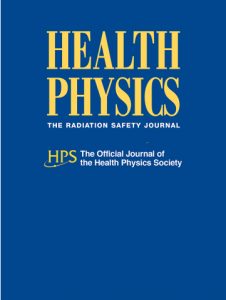I work for a major airline and will be required to spend eight hours a day near the new baggage x-ray machines (the big ones that I think are computerized tomography [CT] machines) that the Transportation Security Administration (TSA) uses. We have been given a handout saying that TSA has determined that the machines are not dangerous and that we do not need film badges. How can anyone say working near radiation is not dangerous if it is not monitored in any way?
Some of the newer x-ray machines used to scan checked luggage use CT technology, just like those used in medicine. The main difference between the two types of use (security at airports and medical diagnosis) is that the machines used in airports have more shielding to stop the scattered radiation. Nearly the entire luggage belt is shielded; in medicine, the patient table is not shielded. Also, the baggage is subjected to lower doses because the image does not need to be as clear as it does for a patient.
Someone standing next to the unit in airports would receive little, if any, radiation exposure. Radiation emitted around a piece of equipment when it is operating is determined by the manufacturer and, sometimes, checked by the purchaser. A manufacturer must assure the equipment is operating within federal regulations that govern x-ray equipment, which in this case is 1.3 × 10-7 C kg-1 at 5 cm from the unit (Coulomb per kilogram [C kg-1] is a unit of radiation exposure), though performance studies of the equipment indicate that the average exposure rate was about 2.1 × 10-11 C kg-1 per scan (NCRP Report 95). Purchasers can use the manufacturer’s assurance and/or can perform their own surveys on the equipment. The dose to the luggage is very low and there is no detectable radiation outside the machines, according to one manufacturer.
What does it mean when my employer says the machines are safe because no “leakage” was found? What is leakage? I work around those big checked luggage scanners, so what does leakage mean to me in terms of radiation exposure?
When we say “leakage,” that simply means when the x-ray beam is on, the tube housing has some radiation coming through it. Actually, it always does and x-ray machine regulations limit the amount that can come through. So, in this case, “leakage” means someone was able to detect radiation being emitted through the tube housing at levels higher than what the regulations allow.
With that in mind, though, it does not mean that radiation was coming through the shielding around the unit. The scanners have shielding around them to make sure the x-ray beam cannot escape and expose people to unnecessary radiation. So even if radiation was leaking through the tube housing when the unit was on, it is unlikely it also went through the unit’s shielding.
When people are not wearing radiation dosimeters, there are a couple of ways to find out if a machine is “leaking.” One is the recognition that the images are not of the same quality as they should be. If the images are deteriorating significantly, it could mean many things, one of which is that not all of the radiation is getting to the luggage. Additionally, the manufacturer or contracted workers will do regular preventive maintenance on the unit, and if they work on the x-ray production portion of the unit, new surveys around the unit must be done to show that radiation protection controls still provide the necessary protection.
Would you recommend the frequency of radiation leakage measurement surveys in an airport environment for the screening equipment?
Every two to three years would be adequate if the machine is not opened for repair. After it is serviced, a radiation survey is a must to ensure shielding and barriers have been repositioned correctly.
What type of instrument can I purchase to do radiation leakage checks on baggage x-ray screening machines?
It is likely you will need two types of equipment to do a leakage survey. The first is a Geiger-Mueller probe with a mica window (i.e., a pancake probe) because it would be the most sensitive to actually find the leakage radiation, if there is any. The second is an x-ray calibrated (calibrated for the energy emitted by the baggage-screening equipment) ion chamber to measure actual dose or dose rate. In the United States, the Food and Drug Administration has regulatory authority over the manufacturers of radiation-producing equipment and have specified a leakage limit of 1.3 × 10-7 C kg-1 at 5 cm from the surface of the equipment (Coulomb per kilogram [C kg-1] is a unit of radiation exposure).
With an airport baggage-screening machine, is it safe to line up bags in a continuous row, which doesn’t allow the lead protection to be completely down when a bag is in the x-ray beam?
Judging by the experience of those who have measured radiation exposures around modern narrow-scanning-beam baggage security screening systems while they are continuously in operation, there is very little scatter from the piece of baggage being screened, so little, if any, radiation even makes it to the lead protection barrier.
I am pregnant and operate an x-ray machine at a courthouse—the type that scans items people carry in with them. Should I have any concerns? Should I continue working?
Baggage x-ray machines emit x rays just like medical x-ray machines, except at much, much lower levels. The location of the operator is very well shielded and, really, exposes no one. It is safe to continue working while you’re pregnant.
Can I put my hand inside a screening x-ray machine to get an x ray to look for injury?
No, absolutely not. These systems are not designed for medical diagnosis and will not provide appropriate image detail or contrast. I would suspect that in most states, this would be illegal. X rays of people should only be done with a doctor’s order to do so.
Is it safe for someone with a medical implant to go through the airport (or office building) metal detectors?
There are two papers published in literature that discuss this. The more recent article, published by M. Niehaus and colleagues in 2001, discusses pacemakers and states: “In 103 patients who were monitored as they passed through typical metal detectors, security alarms invariably were activated. In none of the patients was the pacemaker function affected. It is therefore accepted practice to advise patients that while airport screening devices may detect the pacemaker, the device will not be adversely affected. Patients should carry their device identification card for the purpose of obtaining security clearance.”
According to the articles’ conclusions, patients can go through metal detectors without causing a pacemaker or cardioverter-defibrillator malfunction. For other types of implants, it may be best to ask your physician.
References
Niehaus M, Tebbenhohanns J. Electromagnetic interference in patients with implanted pacemakers or cardioverter-defibrillators. Heart 86:246–248; 2001.
Copperman Y, Zarfati D, Laniado S. The effect of metal detector gates on implanted permanent pacemakers. Pacing Clin Electrophysiol. 11:1386–1387; 1988.
The information posted on this web page is intended as general reference information only. Specific facts and circumstances may affect the applicability of concepts, materials, and information described herein. The information provided is not a substitute for professional advice and should not be relied upon in the absence of such professional advice. To the best of our knowledge, answers are correct at the time they are posted. Be advised that over time, requirements could change, new data could be made available, and Internet links could change, affecting the correctness of the answers. Answers are the professional opinions of the expert responding to each question; they do not necessarily represent the position of the Health Physics Society.






